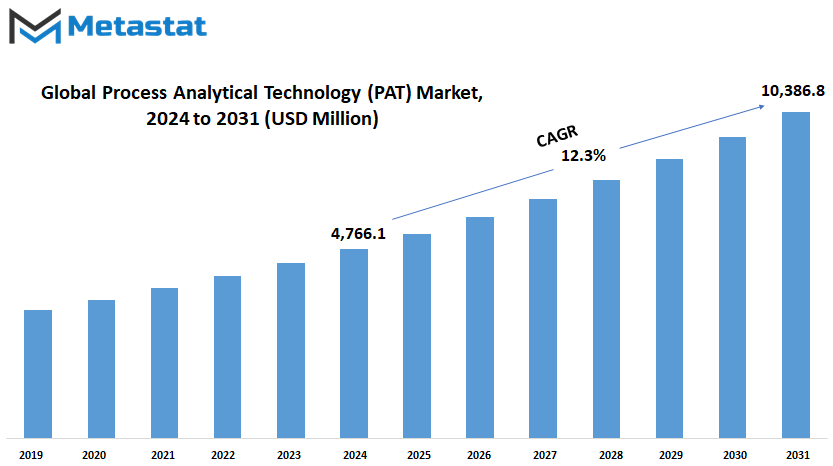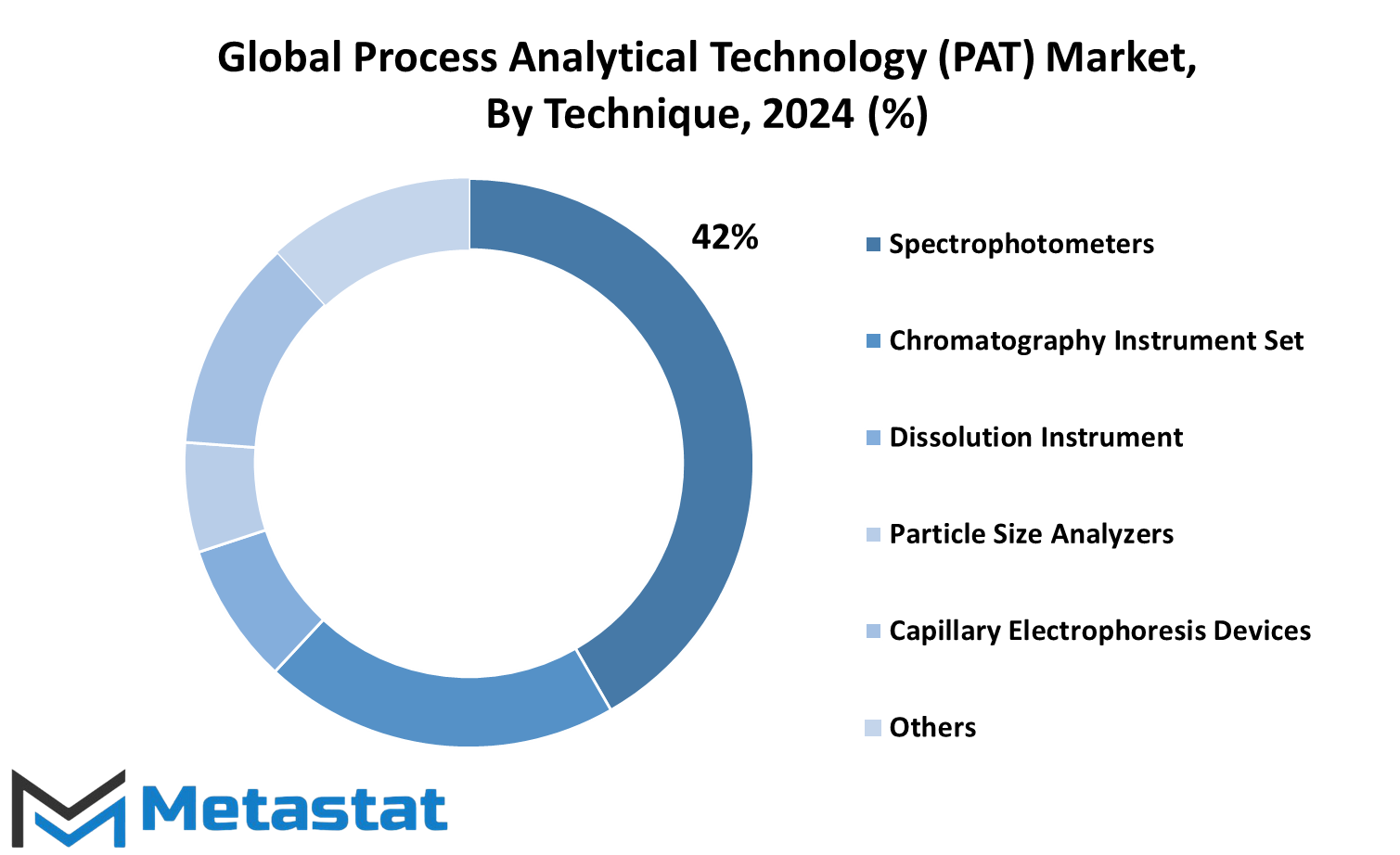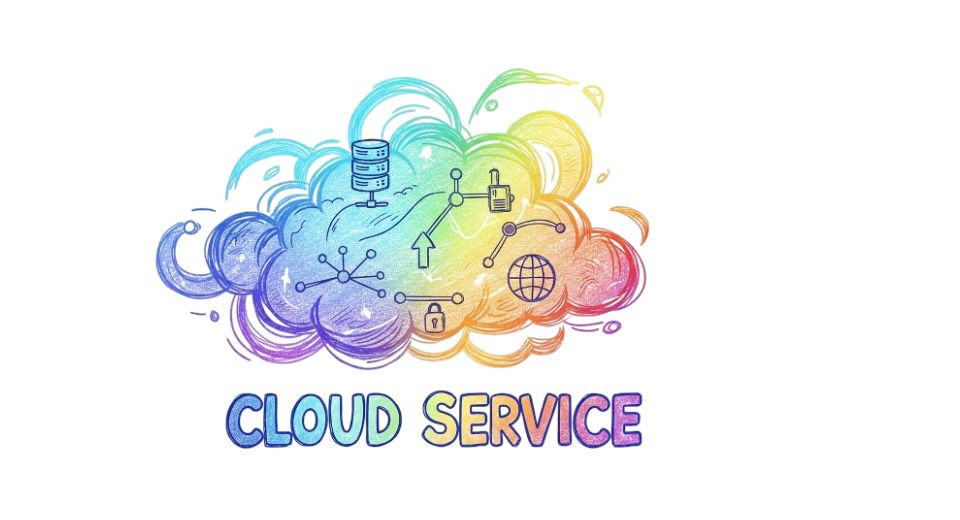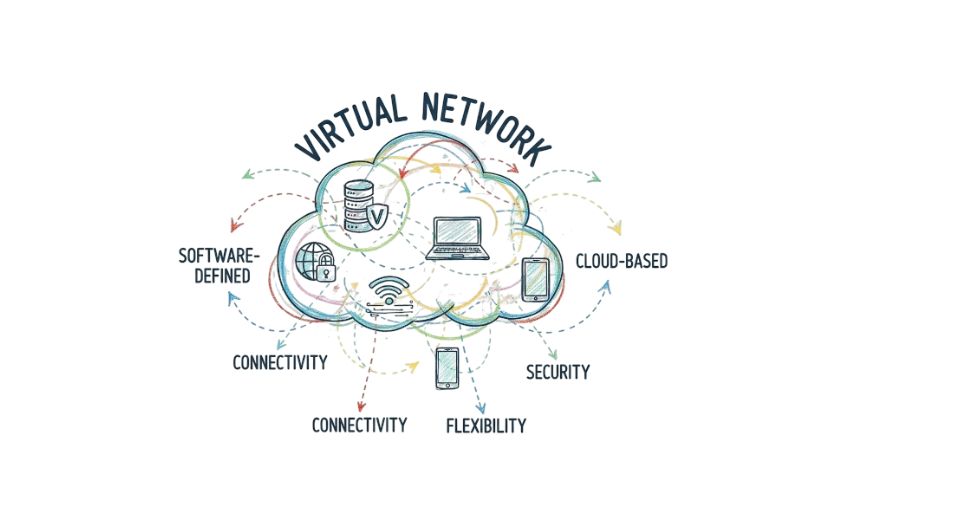MARKET OVERVIEW
The global Process Analytical Technology (PAT) market will thus determine the production and quality control environment for the future of all industries, but particularly the pharmaceutical, biotechnology, and food manufacturing sectors. The PAT market will pay particular attention to the methodologies and tools used in monitoring and controlling production processes such that products are of good quality and with maximum efficiency. In the wake of heightened demands on quality and sharply rising regulatory requirements, the role of process analytical technologies is only going to gain further importance in coming years.
In the pharmaceutical industry, the international market for Global Process Analytical Technology (PAT) would help pharmaceutical manufacturing companies adopt a more efficient way of producing drugs. Advanced tools of analytical measurement will provide real-time monitoring and instantaneous adjustments in critical parameters of the process when required. This capability would enhance the quality of products while minimizing waste and downtime during production processes. PAT integration will allow pharmaceutical companies to speed up their timeline in developing innovative therapies and getting these therapies to market faster.
Biotechnology companies, too, will benefit from progress in the Global Process Analytical Technology (PAT) market. As these companies engage in complex biological processes, the ability to analyze and regulate production in real time will be golden. For instance, implementation of PAT tools in bioprocess optimization will improve yield while consistently increasing the production of biopharmaceuticals. There will also be associated cost savings, thus a motivation to implement process analytical technologies within the biotechnology industry.
Improvement in food safety and quality will drive the global Process Analytical Technology (PAT) market to propel the food industry forward. Increased awareness among consumers regarding health and production procedures of food will compel manufacturers to use PAT to meet regulatory authorities’ requirements and quality standards. PAT will allow the food manufacturing industry to analyze raw materials and final products in real time and identify contaminants and deviations from set standards. In other words, such an initiative will ensure public health and at the same time enhance brand reputation and trust among consumers.
Industry 4.0 initiatives are more and more being integrated with the Global Process Analytical Technology (PAT) market in the spheres of automation and data analytics technologies. The merged PAT market will create a smarter manufacturing landscape whereby interconnected devices and systems enable seamless data flow and decision-making. Predictive analytics would help companies anticipate problems before they start and, therefore, optimize their production processes even better. PAT in conjunction with advanced manufacturing technologies is sure to entail greater overall efficiency and thus a sustainable future for the industry.
In addition, the Global Process Analytical Technology market will be highly driven by a growing demand for personalized medicine and customized production processes. With the healthcare environment changing drastically to result in individual treatments, process analytical technologies will play a significant role in allowing manufacturers to deliver such customized solutions efficiently. That adaptability will be essential for companies to survive in an ever-changing market.
A revolution in the global Process Analytical Technology (PAT) marketplace seems to be the underlying shift which will drive industries in new manufacturing. The strengths in the quality of the product, compliance to regulatory requirements and improvement in efficiency will make it a backbone of new manufacturing. According to the shifting patterns that the future landscape dictates to companies, they should be geared with process analytical technologies which will catapult them to success in a transformed marketplace.
Global Process Analytical Technology (PAT) market is estimated to reach $10,386.8 Million by 2031; growing at a CAGR of 12.3% from 2024 to 2031.

GROWTH FACTORS
PAT is seen to witness massive growth in the worldwide market over the coming years, which will be the result of an array of factors that will change the manner in which industries approach quality control and process optimization. For the largest driver for this growth is the tremendous demand for real-time quality control in manufacturing processes. Businesses now realize the need to monitor processes in real-time concerning the production of its products to maintain a quality level. This is really a huge factor not only in the safety of the product but also in the aspect of efficiency improvement, eliminating error risks, and minimizing waste. As more companies consider streamlining their businesses, PAT systems stand out as a vital tool in achieving these goals.
An increasing trend toward meeting strict regulatory requirements marks the growth of the PAT market. Governments and regulatory bodies worldwide are strictly enforcing standards on product consistency and safety, more so in the pharmaceuticals, food and beverages, and chemicals industries. Regulations are important for high safety standard products having consistency-essential for consumer confidence. PAT technologies provide a solution to firms by allowing continuous monitoring and adjustments for keeping such processes in line with such regulations.
However, despite these benefits, several drawbacks begin to be entailed that may slow down the deployment of PATs. Actually, it is the fact of needing an up-front high investment to implement advanced PAT technologies that poses the biggest challenge. However, the fact is that there are enormous upfront investments required by these systems, and thus, making them unapproachable for small-scale companies. Furthermore, PAT implementation within the existing manufacturing processes can be relatively cumbersome and time consuming. Complexity in the integration may further discourage business entities from maximum utilization of the technology once the old system is not easy to get aligned with the new PAT mechanisms.
Other growing chances occur in the PAT market through the development of sensors and data analytics. Their further evolution only allows for more precise control and monitoring, giving no other option but to take full advantage of the processes with increased accuracy. This may open up additional breakthroughs in the given domain and further enhance performance yet provide a competitive advantage for companies that operate such advanced systems.
In future, the Global Process Analytical Technology (PAT) market will grow as industries look toward efficient ways of ensuring product quality and safety while overcoming the current challenges associated with implementation and integration.
MARKET SEGMENTATION
By Product
Global Process Analytical Technology (PAT) market is expected to rise in the coming years as the needs for strict process control are increasing in the pharmaceutical, biotechnological, and chemical industries. PAT is significant because it takes its importance from real-time monitoring analysis, and control of a production environment for ensuring quality and efficiency during manufacture. This technology continues to gain relevance as industries accept automation and other advanced manufacturing practices. Companies keen on meeting the tougher regulatory requirements, increasing their production yield, or reducing costs will find PAT solutions indispensable.
The Global Process Analytical Technology (PAT) market is classified into several product categories: analyzers, sensors and probes, samplers, software and services. Each of the segments uniquely adds to PAT’s overall functionality. Analyzers are needed for real-time information on the chemical and physical characteristics of substances being produced, which makes this tool sensitive to adjustment from a manufacturer and limits errors and waste. Through time, analytics tools will likely be even more precise and efficient, making outcomes even better in production processes.
Sensors and probes are another important equipment in PATs. Through these equipment, information is generated to monitor the process in real time, and possible monitoring of the quality of the process from time to time. Improvements of sensor technology will progress accuracy and sensitivity up to greater degrees that will be needed to create really sensitive details concerning production processes. This will enable industries quickly to detect variations in any of the production processes and make all the necessary alterations before the problems manifest.
Such samplers would, for example, ensure that there is data which is error-free in the production process. More critical to the ampler, however, would be verification of whether the product meets the quality standards by taking samples at different levels. More future automation may eventually result in the use of automated sampling systems, which would be very efficient when used.
The software and services component of the segment is also expected to increase. With the constant development and enhancement of more complex data analysis and control systems, there is an increasing need for software that can analyze large chunks of data and provide optimized process steps and results. Accompanying this is the provision of services that offer PAT-related companies in assisting industries to adopt and develop technology with previous systems with the least amount of downtime.
By Techniques
Global Process Analytical Technology (PAT) market is moving towards high growth in the next coming years. This market plays an important role in enhancing better efficiency and quality of the manufacturing process, mainly coupled with drugs, which can benefit from advancements in various analytical techniques. Such techniques enable real-time monitoring, thus ensuring that processes meet the desired quality standards, waste reduction, increased productivity, and conformity with the regulatory conditions.
The Global Process Analytical Technology (PAT) market can be segmented on the basis of technique and each of these segments has uniquely contributed to its growth. Among them, the dominant segment would be spectroscopy, which encompasses the usage of spectrophotometers. In 2019, the segment of spectrophotometers alone accounted for 1027.5 million USD, clearly reflecting a significant application in providing accurate measurement during production of chemical and physical properties. It is therefore one of the very important technologies that are being heavily applied in industries such as pharmaceuticals and chemicals because this technology gives revealing details about the composition of substances. Therefore, as the world seeks more precision and conformity, so will the increasing implementation of spectroscopy by companies as more and more companies learn the merits of real-time analysis.
Chromatography is one of the most important techniques in the PAT market, providing a very efficient method for separating mixtures and analyzing complex compounds. It is increasingly used at every level of product quality control and product development, particularly in the pharmaceutical industry. With further technological development, the use of chromatography to ensure proper safety and effectiveness of the final products will continue to grow, thus expecting to impact the overall PAT market growth positively.
Another crucial segment in this market includes particle size analysis, which measures the particles in a substance. In 2019, this segment reached 158.4 million USD and took up 6.3% of PAT. Part of the reason measuring and controlling the particle size is very important has to do with the fact that this matters significantly in industries such as pharmaceuticals because it impacts the effectiveness and purity of drugs. The complexity in formulations related to drugs could significantly demand for the accurate analysis of particles.
Electrophoresis, among others, further increases the application in the PAT market. With constant innovations and evolving existing technologies, the Global Process Analytical Technology (PAT) market is going to witness steady growth in the future years as well. There is significant scope in this market in the short-term future because companies are in search of better process control and quality assurance in various industries.

By Monitoring Method
Global Process Analytical Technology (PAT) Market is growing steadily and, hence, holds a lot of potential for the future. The increased demand from industries keen on enhancing the quality, efficiency, and consistency of their processes has been driving this market. Essentially, PAT is a system designed to analyze, control, and improve production methods in real time while ensuring strict adherence to the standards related to the quality of the products. With these technologies implemented in pharmaceuticals, chemicals, and food processing industries, the importance will continue to grow.
It is due to innovations and pressure from regulatory elements that will rise the demand for PAT globally in the future. Manufacturers are shifting towards smarter systems, using more advanced technologies to monitor and control their operations. Such advancements are targeted toward the diminution of human error, waste, and the enhancement of product quality-all of which play an important role in the globalizing economy of today. Of course, perhaps the future should have PAT as the core to ensure that these objectives take place in an efficient manner.
To segment these markets, there are four types of on-line monitoring methods: in-line, at-line, and off-line. Each has its own advantages with respect to the requirements of the industry and its process. In-line monitoring, for one, allows for uninterrupted observation and gives back feedback right during the production process, and it is finding favor recently especially with industrial applications that require the data in real-time so spontaneous adjustments can be made. In-line monitoring is similarly very useful mostly because the monitoring may be carried out in line with the production process, and it also affords real-time control without an interruption in the flow of the process. The on-line method, where the analysis of the sample is conducted near the production line, delivers the quickest feedback without fully committing to any form of real-time monitoring.
This technique is most suitable when quick answers are required, but it is not highly necessary to make instant changes. Last and least is the Off-line monitoring; this requires the sending of samples to a remote laboratory for them to be analyzed, and it is less common today as industries shift more towards more prompt solutions. However, still, this is important for systems where major analysis is required and time is not the critical issue. As the global PAT market continues to progress, these monitoring techniques will remain perfected and continue to advance and improve, giving industries the tools necessary to remain ahead in a highly competitive environment. The focus on smarter, more efficient production processes will ensure that the market continues to flourish, making PAT an indispensable part of future industrial advancements.
By Application
The global process analytical technology market overview Industry after industry is looking for more efficient processes in monitoring and controlling manufacturing. This is when PAT steps into the picture as a Quality Framework and has been an imperative technology application in pharmaceutical, biotechnology, and chemical sector applications. The market of PAT is going to see tremendous growth in the coming years because companies are increasingly realizing the need for advanced technologies that can help streamline their operations, minimize waste, and ensure product consistency.
Global Process Analytical Technology market can also be divided into specific divisions based on application. It is further divided into small molecules, large molecules, manufacturing applications, and other applications. Each category provides specific benefits and is crucial to the overall market. In the case of small molecules, which are a main component of pharmaceutical products, PAT plays a crucial role in maintaining the exact chemical composition and quality required to comply with regulations. In the future, as pharmaceutical companies create more complex therapies, it is likely that the need for real-time monitoring by PAT will rise. This will be critical to ensure safety and efficacy for these small molecule drugs.
For the large molecule segment encompassing biologics such as vaccines and proteins, PAT is very helpful also since these are normally sensitive to environments. Continuous monitoring must be done to these products. In the near future, this market is expected to surge forward with the increasing share of large molecules in the healthcare sector from biopharmaceuticals. PAT will further play a more significant role in helping companies to maintain the stability and quality of these products during its production in real-time data availability.
Another big category is manufacturing applications, where PAT will be used more extensively in industries where efficiency and high quality of the final product are definitely important. This varies from food production to chemical manufacturing, and the possibilities in real-time data for optimizing production lines would ensure less downtime and no material waste. Better sensors and data analytics should reasonably improve the capability of PAT in terms of manufacturing processes, increasing automation and predictive approaches for process control in the future.
Global Process Analytical Technology (PAT) to 2022 is in promising light since almost all industries utilize these technologies to meet the incoming demand for high-quality products. Applications across many sectors make PAT a more integral part of modern production processes during the coming years.
|
Report Coverage |
Details |
|
Forecast Period |
2024-2031 |
|
Market Size in 2024 |
$4,766.1 million |
|
Market Size by 2031 |
$10,386.8 Million |
|
Growth Rate from 2024 to 2031 |
12.3% |
|
Base Year |
2022 |
|
Regions Covered |
North America, Europe, Asia-Pacific Green, South America, Middle East & Africa |
REGIONAL ANALYSIS
For instance, the global market for Process Analytical Technology (PAT) will have a great rate of growth in the coming years. This is basically because PAT applications are found in a number of significant industries such as pharmaceuticals, biotechnology, and chemicals. The state of technology in a region is essential in defining the future of PAT. In terms of the geographical landscape, each region has specific contributions to the overall growth of the market.
North America and the global market hold significant importance for Process Analytical Technology. The major pharmaceutical companies have driven the market forward as well as technological advancements in the region, whereas the U.S. assumes the largest market share in this region followed by Canada and then Mexico. As industries want to go for more and more efficient production methods, this region is likely to take PAT adoption very strongly. The North American regulatory bodies have also been very cooperative and would help in forming a scenario wherein new technologies can be implemented with less hassle.
The PAT adoption is also being dominated by countries like the UK, Germany, France, and Italy in Europe. The region concentrates on innovation, sustainability, and compliance with regulations, making this region very essential in this market. The region is set to record steady growth, and the quality control processes are set to be enhanced in many industries. Sustainable practices and waste reduction in the manufacturing sector of Europe may drive attention to PAT in terms of efficiency and quality.
Asia-Pacific is expected to grow rapidly in this PAT market. Major economies, including India, China, Japan, and South Korea, will drive the fastest growth in the region, as they invest heavily in industrial automation and pharmaceutical manufacturing. PAT will gain more traction as these countries advance their manufacturing capabilities and enhance their production efficiency. Additionally, government policies to encourage technological innovation in such countries will also result in increased demand for PAT instruments.
Brazil and Argentina are dominant markets in South America, which will spur development in the area as a whole. PAT adoption is progressing more slowly compared to other parts of the region, but market stimuli toward modernizing industries and making production more efficient will drive growth in the near term.
In the Middle East & Africa region, the adoption of PAT is still in its earlier stage, but it promises much. Its GCC Countries, Egypt, and South Africa, appear to take the lead in this regard with growing interest in modernizing their production processes. When industries develop in this region, more will focus on adopting such advanced technologies as PAT for raising productivity and competing in the global market.
COMPETITIVE PLAYERS
One of the drivers to further growth of the Global Process Analytical Technology (PAT) market is considered to be an increase in technology and focus on efficiency enhancement in various industries, like pharmaceutical, biotechnology, or food production in their manufacturing processes. PAT is considered an excellent tool that acts as a tool for delivering quality products and reducing the cost of production. More automated, data-driven approaches in industries will also spur higher demand for PAT systems.
Leaders in the Process Analytical Technology Market are now accelerating with the pace of this development. These leaders include Thermo Fisher Scientific Inc., Repligen Corporation, Bruker Corporation, and Agilent Technologies, Inc. Investments in research and development can help improve instruments that make analytical tools even more efficient and user-friendly. Therefore, we will also see such players introduce high-performance PAT systems that could allow the analysis of real-time data at production time. Innovations in PAT in the near future will be associated with artificial intelligence and machine learning to enhance further accuracy and speed in analytical processes.
Besides the leading players, new market entrants could also play a substantial role in increasing demand for more effective manufacturing solutions. Companies such as ABB Ltd., Danaher Corporation, and PerkinElmer, Inc., would expand portfolios and offer more industry-specific solutions. This is going to become even more competitive with further growth of the market, where such companies are likely to develop even more sophisticated tools that will benefit a wide variety of applications.
Regulation will continue demanding more from the Global PAT market. Governments and agencies worldwide are pushing for a quality control regime, particularly with pharmaceutical and food products. This will consequently make companies like Emerson Electric Co., Sartorius AG, and Mettler-Toledo all more innovative and refining their offerings to meet those demands.
The overall outlook for the Global PAT market is promising due to continuous improvements and innovative designs taking place across all industries, driven through continuously developed advancements. This line will also be influenced by the competitive players-including Shimadzu Corporation, Hamilton Company, and Carl Zeiss AG-who will continually make improvements in analytical technologies while creating solutions that match the steadily increasing demands of modern manufacturing environments.
Process Analytical Technology (PAT) Market Key Segments:
By Product
- Analyzers
- Sensors & Probes
- Samplers
- Software & Services
By Technique
- Spectroscopy
- Chromatography
- Particle Size Analysis
- Electrophoresis
- Others
By Monitoring Method
- On-line
- In-line
- At-line
- Off-line
By Application
- Small Molecules
- Large Molecules
- Manufacturing Applications
- Other Applications
Key Global Process Analytical Technology (PAT) Industry Players
- Thermo Fisher Scientific Inc.
- Repligen Corporation
- Bruker Corporation
- Agilent Technologies, Inc.
- ABB Ltd.
- Danaher Corporation (Ab Sciex LLC)
- PerkinElmer, Inc.
- Emerson Electric Co.
- Sartorius AG
- Mettler-Toledo
- Shimadzu Corporation
- Hamilton Company
- Carl Zeiss AG (Zeiss Group)
WHAT REPORT PROVIDES
- Full in-depth analysis of the parent Industry
- Important changes in market and its dynamics
- Segmentation details of the market
- Former, on-going, and projected market analysis in terms of volume and value
- Assessment of niche industry developments
- Market share analysis
- Key strategies of major players
- Emerging segments and regional growth potential








 US: +1 3023308252
US: +1 3023308252






